For foreign visitors, the result of the contest “bánh chưng vs. bánh tét” is hard to determine since they sound almost identical. So, in this post, I will compare these two treats to help you understand their resemblances and dissimilarities.
This post will provide a deeper understanding of the ingredients, cooking methods, and cultural roles of bánh chưng and bánh tét. You also get to learn about the history and symbolism behind these dishes.
So, if you’re ready to learn more about bánh chưng and bánh tét, let’s go!
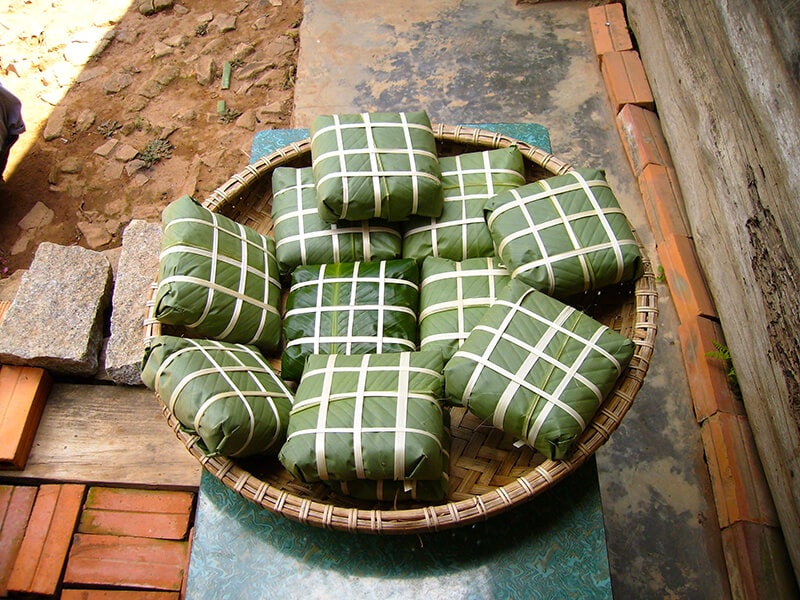
General Information About Bánh Chưng
Bánh chưng/banh chung gets its English name, “Vietnamese square cake”, due to its appearance. The locals explain its distinctive look with a legend of vua Hùng/Emperor Hung Dynasty.
At that time, the emperor held a cooking competition among his sons to choose the suitable one for his throne. And the 18th prince, Lang Liêu/Lang Lieu, had made 2 cakes in 2 shapes. The square one represents the earth, and the round one represents the sky.
These two cakes are respectively banh chung and bánh dày/banh day. From there, banh chung has become an indispensable element of Northern Vietnamese people’s dining table during the Lunar New Year (Tet). Some families even make banh chung themselves. (1)
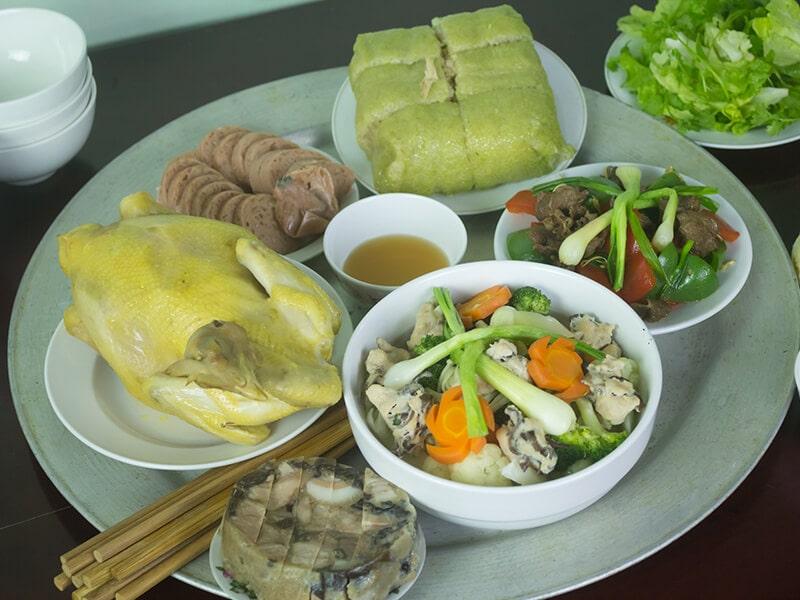
A Brief Introduction About Bánh Tét
Like banh chung, bánh tét/banh tet is a familiar Vietnamese dish for the Lunar New Year, especially in the South. It also appears in several daily meals, but that isn’t the usual case.
Banh tet is thought to be younger than banh chung. Some claim it was born during the Tay Son rebellion (1771-1785) since the army needed a dish with a long storage life. So, the local people made banh tet for them.
Banh tet also has another meaning. Its leaf wrapping reminds eaters of how a mother holds her child or how a family supports each other. That explains why Southern locals hold such high regard for this dish. (2)
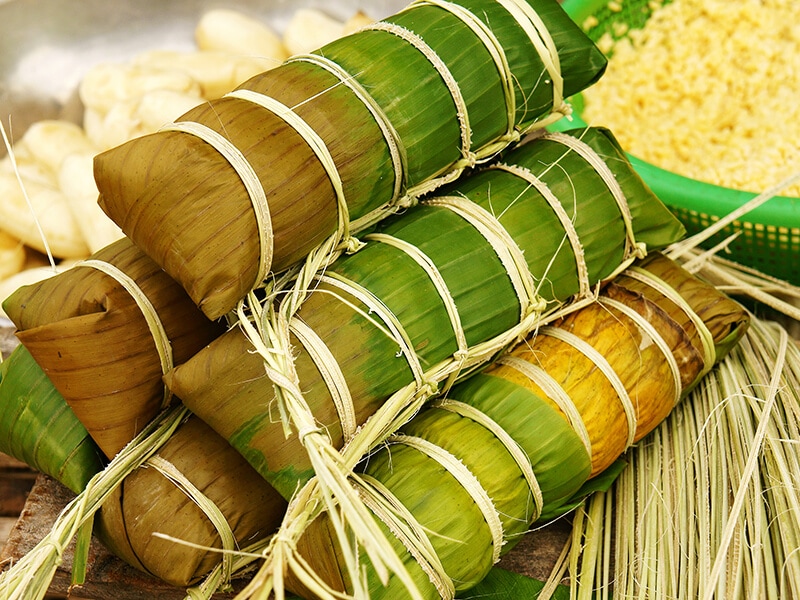
Similarities Shared By Bánh Chưng And Bánh Tét
Even though banh chung and banh tet represent two different regional cuisines in Vietnam, they share more similarities than you thought. Let’s discover now!
Ingredients
The first aspect I think about when mentioning banh chung and banh tet is their ingredients. They all use glutinous rice, mung beans, and pork meat.
Among them, mung beans are the most critical ingredients. As the pork fat will melt during cooking, you need these mashed beans to absorb it, so your cakes won’t become soggy afterward.
Cooking Method
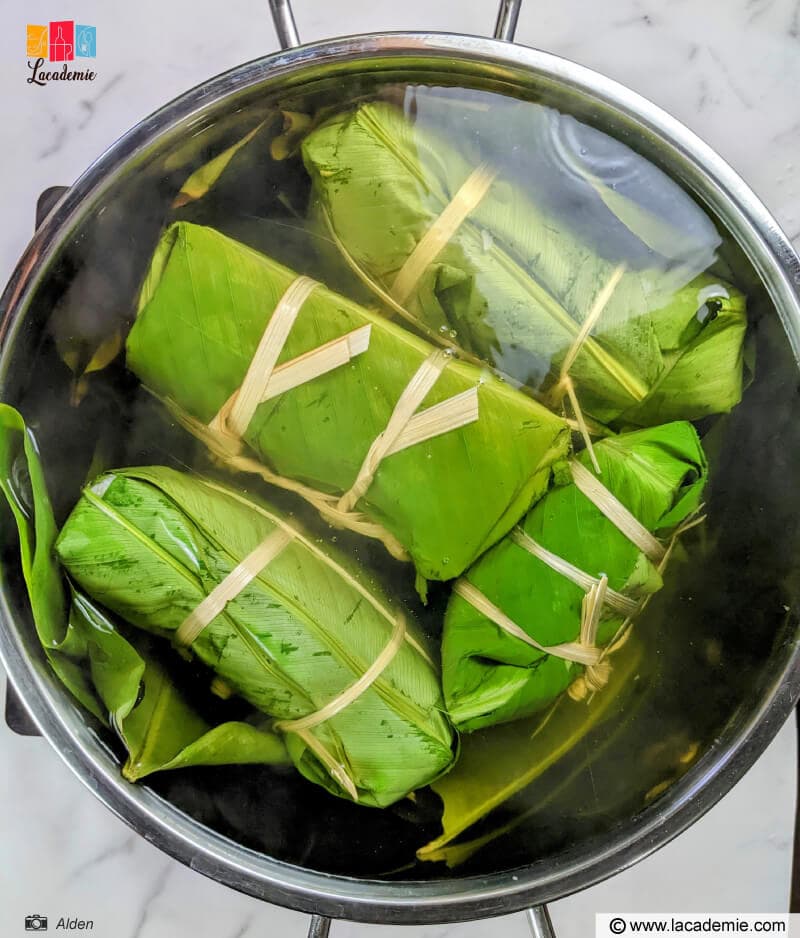
Not only ingredients, but these two cakes also have the same cooking method. When you have all the necessary ingredients, you need to assemble them on several large leaves. And wrap them together to form the signature shape of each cake.
Then, the locals cook them in a large pot filled with water. The cooking period varies depending on the number of cakes. But usually, it can take a whole night. Afterward, they hang the cakes to drain the excess water and make them firmer.
One vital part of this process is wrapping the leaves as tightly as possible. Or else, the water can soak into the cake, and the filling will fall apart.
Cultural Importance
As I’ve mentioned above, banh chung and banh tet usually appear during Lunar New Year (Tet). Vietnamese people will cook them before Tet comes. And then place these cakes on the family altar as an offering to the ancestors, hoping they will keep protecting the family.
Moreover, banh chung and banh tet are considered a way of connecting family. Before, all family members took turns watching the pot all night long. The elders would tell different stories from their times, and the youngsters would play some traditional or card games.
Learn how important banh tet is to Vietnamese culture.
Differences Between Bánh Chưng And Bánh Tét
And here is the main part of this article! After reading this section, you’ll never worry about if you choose the wrong type. All answers lie below, so start reading now!
Appearance
The most significant gap between banh chung and banh tet is their looks. While banh chung has its signature square shape, banh tet looks like a thick log with a cylindrical shape.
Also, they use different wrapping leaves: dong leaves (lá dong) for banh chung and banana leaves for banh tet. So their green colors will be slightly different.
Flavor
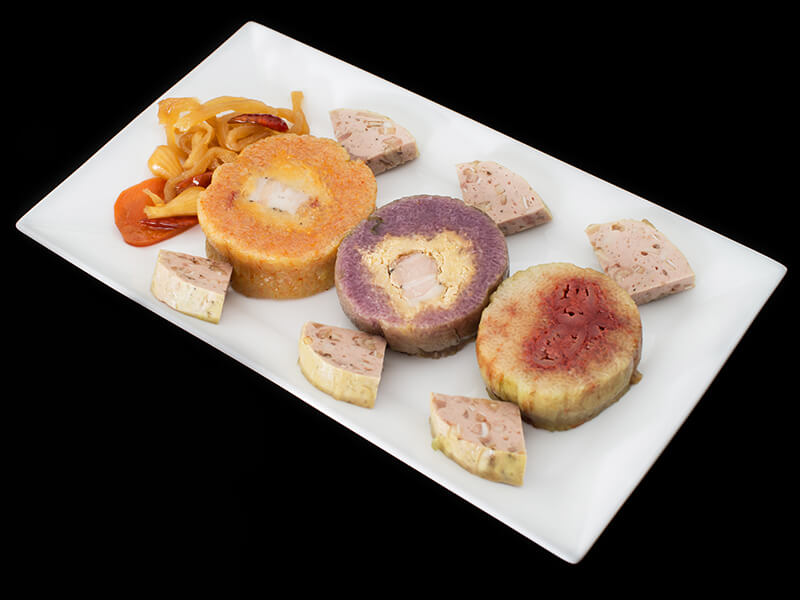
Since the main ingredients are identical, banh chung and banh tet do share some similarities, such as chewiness and sweetness from mung beans.
However, the gap between these two’s taste is still bigger. As the pork meat in banh chung needs to have lots of fat, the result is much fattier and more savory.
Moreover, although both have sweet versions, sweet banh tet is more popular with the banana or coconut types. Meanwhile, in the North, sweet banh chung will use molasses and brown sugar for the filling.
Necessary Equipment
With different shapes, the required equipment for banh chung and banh tet will also vary. Most of the time, banh tet won’t need special tools since its form is easy to make. You only need a strong plastic rope or ribbon to wrap it tightly.
But banh chung is another story. Not many people can create a perfect square shape from zero, so the locals prepare a square mold to make the process easier. Another vital tool is bamboo strings. Besides wrapping the cake, the locals use them to cut banh chung.
To many Vietnamese people, folding and shaping banh chung is an art.
How To Eat
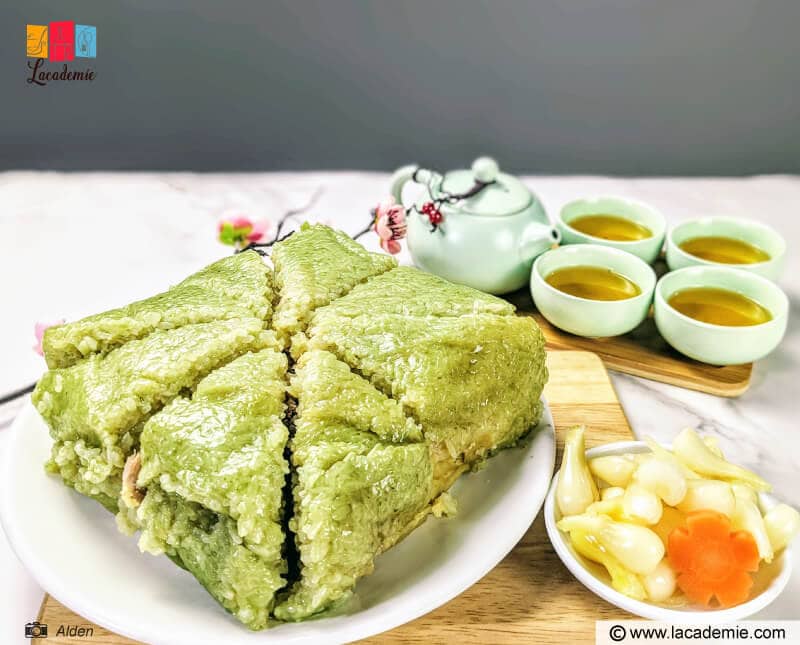
Well, I know you can just cut these cakes and eat them as they are. But that way won’t deliver their true potential. The dipping sauce and accompaniments will do that for you.
Northern people often eat banh chung with pickled onions (củ kiệu) since their sourness will neutralize the cake’s rich and greasy flavor. Another fun way to eat it is to sprinkle some sugar on it. Sweet sugar goes perfectly with the savory and nutty filling.
Additionally, with leftover banh chung, people will fry it to eliminate the sogginess and enhance the flavor. In contrast, the Southern locals will dip banh tet in soy sauce. They also use sugar with banh tet, but only for the sweet version.
Detailed Making Process Of Bánh Chưng And Bánh Tét
Nowadays, with various modern kitchen appliances, cooking banh chung and banh tet is a more manageable challenge. You can easily make these cakes with a thorough guide.
Ingredients
Of course, you’ll want the most authentic version. That’s why I’ve included the same ingredients Vietnamese use to make banh chung or banh tet.
- Sticky rice
- Mung beans
- Pandan leaf extract
- Coconut milk
- Pork belly
- Dong leaves/Banana leaves
- Bamboo strings/Kitchen twines
- Salt
- Sugar
- Pepper
- Crushed shallots
Directions
Although they take a long time, banh chung/banh tet is simple to make. Follow my instructions, and you can succeed right the first time.
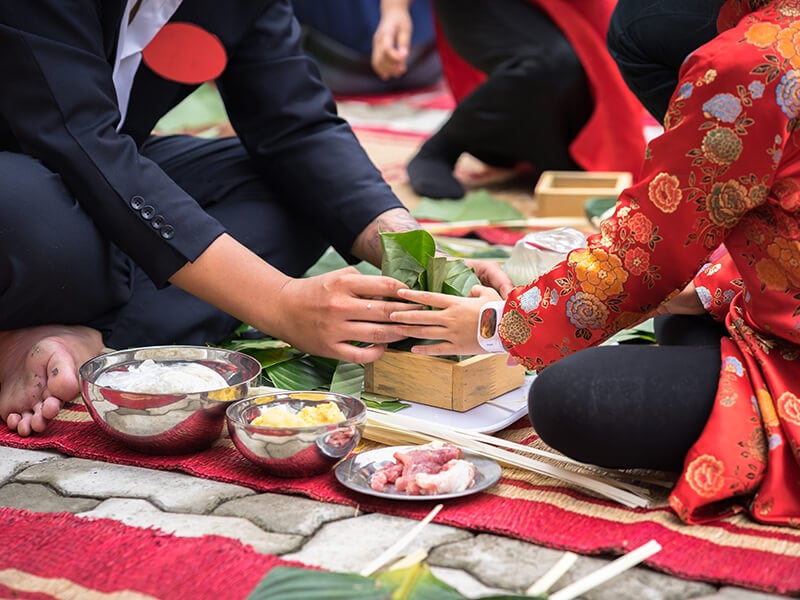
Step 1: Prepare The Ingredients
Wash the wrapping leaves thoroughly and wipe them dry. If you use bamboo strings, soften them in water.
Wash the sticky rice and soak them for at least 4 hours. Then, drain it and let it dry completely. Repeat the same process with mung beans.
Step 2: Marinate The Meat
Cut the pork belly into pieces of the same size. Then, marinate them with salt, sugar, pepper, and crushed shallot.
Step 3: Cook The Mung Beans
Boil the mung beans until softened (about 20 minutes). Season them with salt and sugar. Keep cooking until smooth.
Step 4: Cook The Rice
Mix the dried rice with pandan extract, coconut milk, salt, and sugar. Then, stir-fry the mixture over medium flame. Stir until the rice has absorbed all flavors and set it aside.
Step 5: Wrap The Cakes
Place the glutinous rice, mung beans, and pork belly on the wrapping leaves and wrap them into a square or log shape. If you have never wrapped banh chung, you can refer to this guidance on making banh chung for more detailed steps and more illustrations.
Step 6: Cook The Cakes
Line your pot with the remaining dong or banana leaves. Place the cakes inside, standing upright. Pour in water until it covers all the cakes. Cook them for 8 hours.
Check occasionally. If the water has significantly reduced, add more boiling water so your cakes won’t burn. Turn the cakes halfway through to ensure they’re cooked evenly.
Step 7: Remove The Cakes
Use a tong to take the cakes out of the pot. Rinse them in cold water and press them with a flat, heavy object to drain the excess water and help the texture become firmer. Hang the cakes or store them in a dry place.
Step 8: Unwrap And Cut The Cakes
Remove the wrapping leaves and use the bamboo strings to cut the cakes. Or you can wrap your knife with plastic wrap and cut it like a regular cake.
If you’re still unclear about some steps, refer to this banh tet guidance.
Notes
Here are some notes to help you make these cakes easier.
- Fish sauce is a big no-no for banh chung/banh tet because it quickens the spoiling process.
- The cooking time depends on the size and number of cakes, but 8 hours is the golden answer. Boiling them for too long will leave these cakes mushy. But you shouldn’t end the cooking process too soon since the cakes will become stiff.
- Wrapping leaves should have the same size and a bright appearance. You can blanch the leaves in advance to retain their color.
FAQs
While the main section has cleared all the common confusion between banh chung and banh tet, I believe you still have some questions left. Don’t worry; this section will answer all common problems about these two cakes.
Bánh Chưng Vs. Bánh Tét: A Never-Ending Battle
With a rich history and unique recipes, banh chung and banh tet offer a glimpse into Vietnamese cuisine. I hope this post has helped you gain a deeper appreciation for these dishes and the cultural heritage they represent.
Feel free to share your thoughts and experiences with these cakes in the comments section. If you found this post informative and enjoyable, please like, share, and spread the word about it.
References
- Bánh chưng (2023) Wikipedia. Wikimedia Foundation.
- Bánh tét (2023) Wikipedia. Wikimedia Foundation.


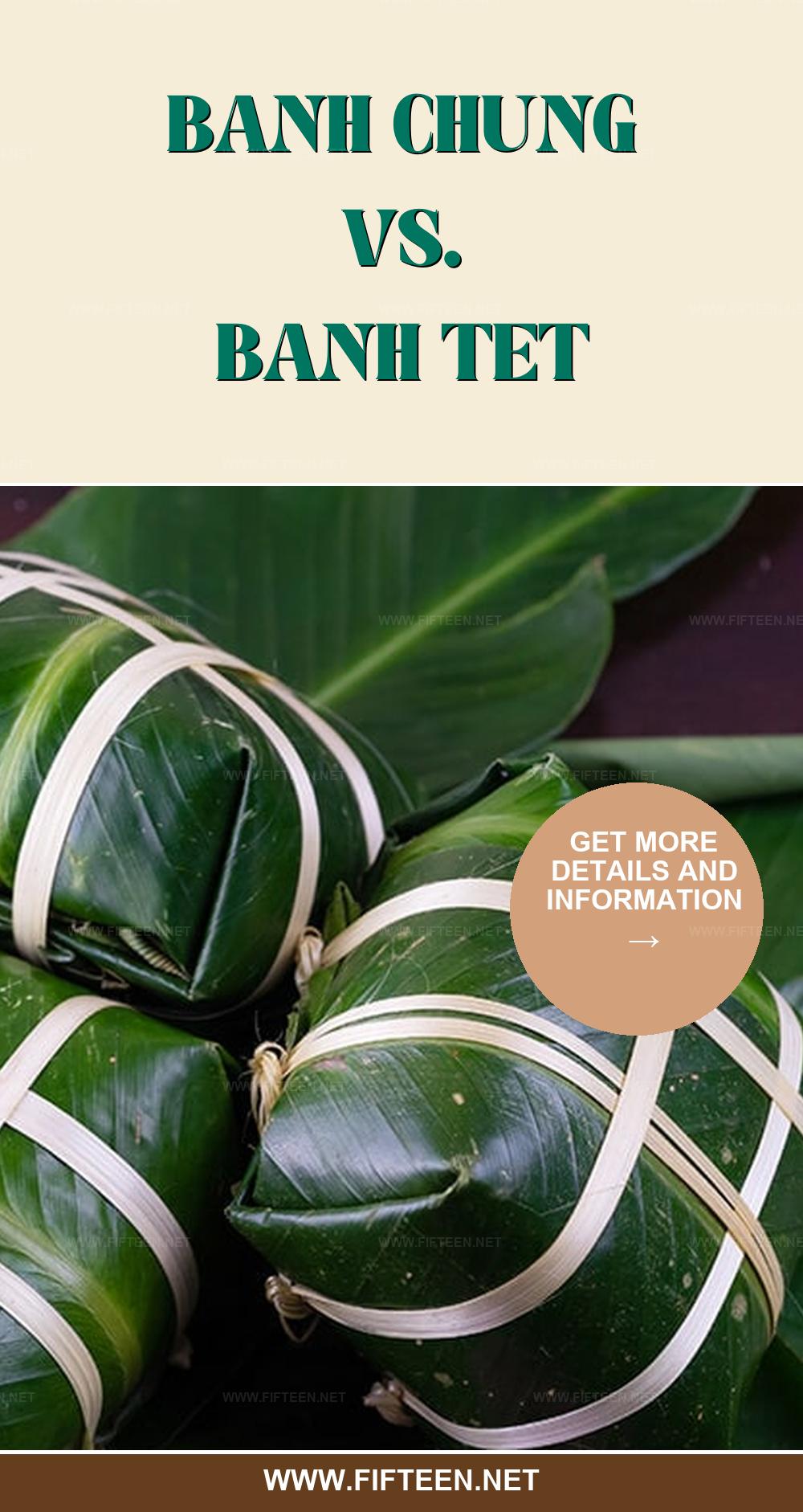
Jamie Scott
Editor in Chief, Senior Content Writer
Expertise
Home Cooking, Meal Planning, Recipe Development, Baking and Pastry, Food Editor, Cooking-video Maker, Western Food Evaluation Expert
Education
Le Cordon Bleu College of Culinary Arts
Local Community College, New York, NY
Jamie Scott is a skilled culinary expert and content creator specializing in Western cuisine. With over 15 years in the culinary field and formal training from Le Cordon Bleu, Paris, Jamie deeply understands how to blend nutrition with delicious flavors. His passion for cooking matches his commitment to making healthy eating accessible and enjoyable.
On Fifteen.net, Jamie brings a fresh perspective to classic dishes and beverages, offering readers insightful recipes, cooking tips, and a fresh view on meal planning that emphasizes taste, health, and simplicity.